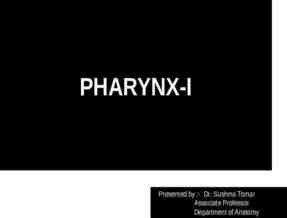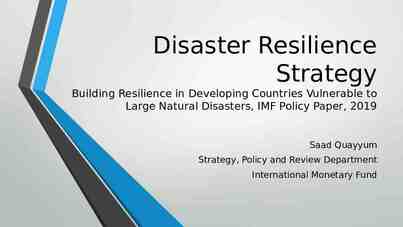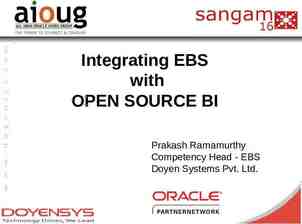Security Overview Luca Canali, CERN Distributed Database Operations
19 Slides2.41 MB

Security Overview Luca Canali, CERN Distributed Database Operations Workshop April 20-21 2009, Barcelona CERN IT Department CH-1211 Genève 23 Switzerland

Outline Review of database security – Sharing experiences – Coordinate homogeneous effort across 3D community Main areas of interest – Threats to DB-centric applications – Actions to mitigate risks – Procedures and policies CERN IT Department CH-1211 Genève 23 Switzerland

DB Security Threats Databases and DB applications are vulnerable at various levels, notably: – – – – DB-specific security bugs Application-related vulnerabilities User-related vulnerabilities External vulnerabilities (network, OS, etc) Risks: – Unauthorized access, defacing, worms, downtime, serious damage – Negative press exposure – Data theft CERN IT Department CH-1211 Genève 23 Switzerland

DB Security Bugs 1/3 DB-specific bugs are addressed by Oracle’s CPU patches – Many fixes are for internal packages who suffer SQL injection or other major vulnerabilities – CPU patches expose the vulnerabilities to the community - exploit come out on the internet – CPU patches come with a score for the vulnerability – The most dreaded are vulnerabilities that can be remotely exploited – Incidents like SQL slammer worm may happen again CERN IT Department CH-1211 Genève 23 Switzerland

DB Security Bugs 2/3 Our experience – Apply CPU patches asap (after a validation period of about 3 weeks) – Users’ privileges are limited to the necessary set (no ‘any’ operations to users) – Read only accounts are treated as the read-write accounts for access security (privilege escalation is a big risk) – Read regularly blogs and security mailing lists for new threats, exploits, etc – Coordination within IT with the security team and between DBAs CERN IT Department CH-1211 Genève 23 Switzerland

DB Security Bugs 3/3 Our experience – Many packages in Oracle are ‘grated to public’, we revoke at installation some that are know to have (or have had) security flaws revoke execute revoke execute revoke execute revoke execute revoke execute revoke execute revoke execute public; CERN IT Department CH-1211 Genève 23 Switzerland on on on on on on on sys.lt from public; dbms cdc subscribe from public; dbms cdc isubscribe from public; sys.utl tcp from public; sys.utl http from public; sys.utl smtp from public; sys.dbms export extension from

Application Related Vulnerabilities 1/2 Applications’ vulnerabilities open the way to DB access – SQL injection is a typical example – Other vulnerabilities of the app server can give an attacker full control on DB connection – A simple mistake on the application code can open the way for attacker to execute arbitrary SQL at least on one schema CERN IT Department CH-1211 Genève 23 Switzerland

Application Related Vulnerabilities 2/2 Our experience – During validation phase we look at possible vulnerabilities – Recent example: suggested use of bind variables against SQL injection – Other example: protect the application with NICE credentials (see DB monitoring) – For our own ‘DBA applications’: we take care not to expose passwords – Overall it’s the developers’ responsibility to secure the application but DBAs can provide useful feedback CERN IT Department CH-1211 Genève 23 Switzerland

Users’ Generated Vulnerabilities 1/2 Users can fail to protect the DB access – They may open easy way for an attacker to enter the DB – Social engineering is also a threat – Overall a collaborative environment is more prone to security holes CERN IT Department CH-1211 Genève 23 Switzerland

Users’ Generated Vulnerabilities 2/2 Our experience CERN IT Department CH-1211 Genève 23 Switzerland – We use a password scanner to warn users of weak passwords we force password complexity (and account expiration) – We keep track of account owners – Accounts and passwords can leak on the internet and search engines – Tnsnames can also leak to google – CVS is another potential pitfall – Wikis and monitoring tool should take care not to expose too much information on the setup – Overall it’s the users’ responsibility, DBAs can put in place tools and awareness of risks to help

External Vulnerabilities The OS and network need to be protected too: – Other (non-Oracle) vulnerabilities can be used to enter the DB – If an attacker can break into the server, the DB is owned too CERN IT Department CH-1211 Genève 23 Switzerland

External Vulnerabilities Our experience – – – – Firewall access to DB server Add local iptable firewall Use non-default listener port Regularly apply OS patches as provided by Linux support – Patches are applied in a rolling way, on scheduled maintenance CERN IT Department CH-1211 Genève 23 Switzerland

Challenges of a distributed environment In a distributed environment if one target is broken into, the others may be at risk Our experience – None so far, fortunately! – CERT IT security team and service managers will work together in case of security issues CERN IT Department CH-1211 Genève 23 Switzerland

Digression on CPU Patches Are CPU patches adding security to the system? – It is found that several Oracle users do not apply CPU patches at all – They rely on securing the DB with firewalls and/or hoping for the best! – Old method of ‘securing’ the DB, where one would also find weak password CERN IT Department CH-1211 Genève 23 Switzerland

Digression on CPU Patches The answer in my opinion is yes, but only if the CPU patches are applied in a timely manner CERN IT Department CH-1211 Genève 23 Switzerland – After CPUs are out, details on the vulnerability come out too from security experts – It makes easy for non-experts to build exploits – One can also simply look at the patch files and find vulnerable pieces of code – Example CPU Apr09 has a sql injection vulnerability in a procedure inside dbms aqadm sys that can be easily seen just comparing old and new code! – Another example, CPU APR09 exposes that Oracle 9.2.0.8 has a high score vulnerability on the resource manager

Auditing Auditing CERN IT Department CH-1211 Genève 23 Switzerland – In auditing logs there is a large amount of information that can be used for security purposes – Identify unauthorized logons or attempts – OS and DB auditing can be used together – DB auditing can produce a lot of information and have a high performance impact – Our experience: to use auditing it’s necessary to have a ‘clean up job’ too or the audit table will fill up quickly. – Custom scripts and EM functionality have already some processing of audit logs at CERN

AUDITMON project AUDITMON – A project that has been recently started, collaboration IT-DM, IT-DES – A tool to automate the analysis of logon auditing – Will be customized for each experiment – Will make use of a common repository of audit data – Will work with rules (2 sets: one to move audit data to the repository and one to process data) CERN IT Department CH-1211 Genève 23 Switzerland

Other Areas of Oracle Security Security policies and actions can grow to be highly sophisticated, depending on the industry. It’s worth mentioning: – – – – – – – – CERN IT Department CH-1211 Genève 23 Switzerland Encryption of Oracle*net traffic Encryption of Oracle data and/or backups DDL auditing DML auditing DB privilege usage auditing Fine grained data access Auditing of DBA actions Penetration testing

Summary DB security status is no different from other applications areas Multiple threats and security risks are identified Keeping the infrastructure secure is an ongoing process (and a ‘moving target’ too) In a distributed environment sharing experiences is a must CERN IT Department CH-1211 Genève 23 Switzerland






